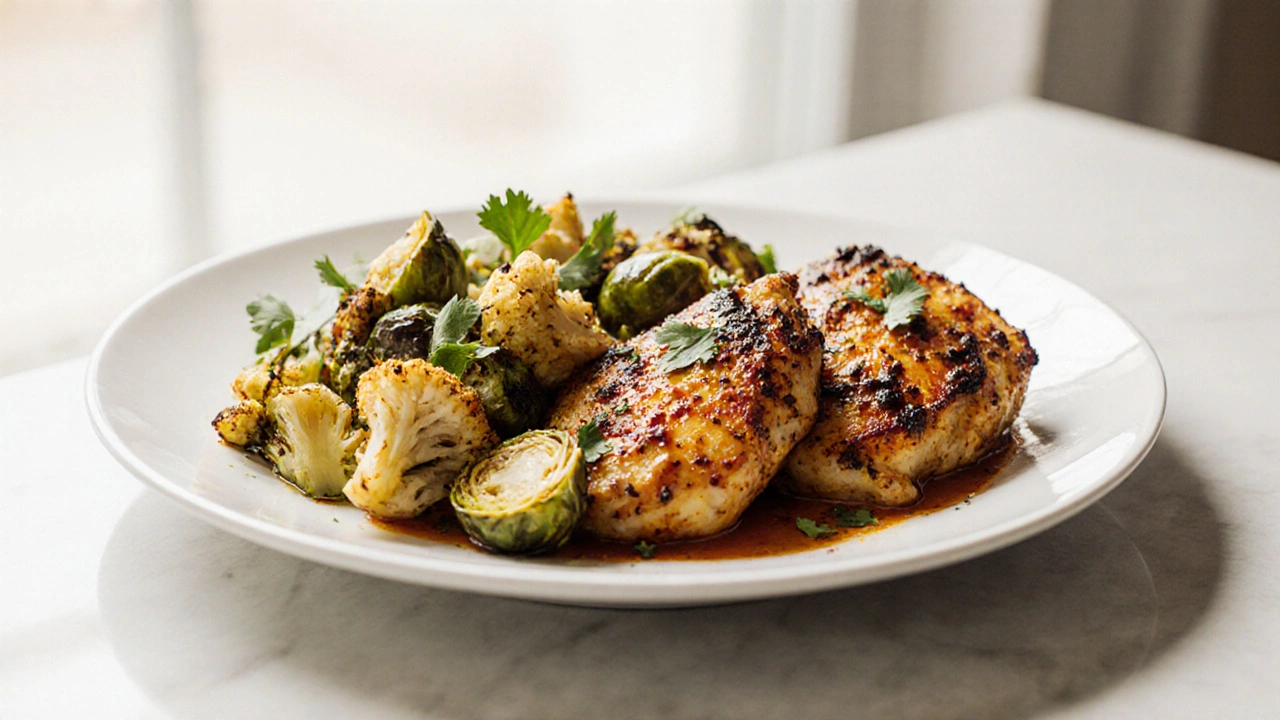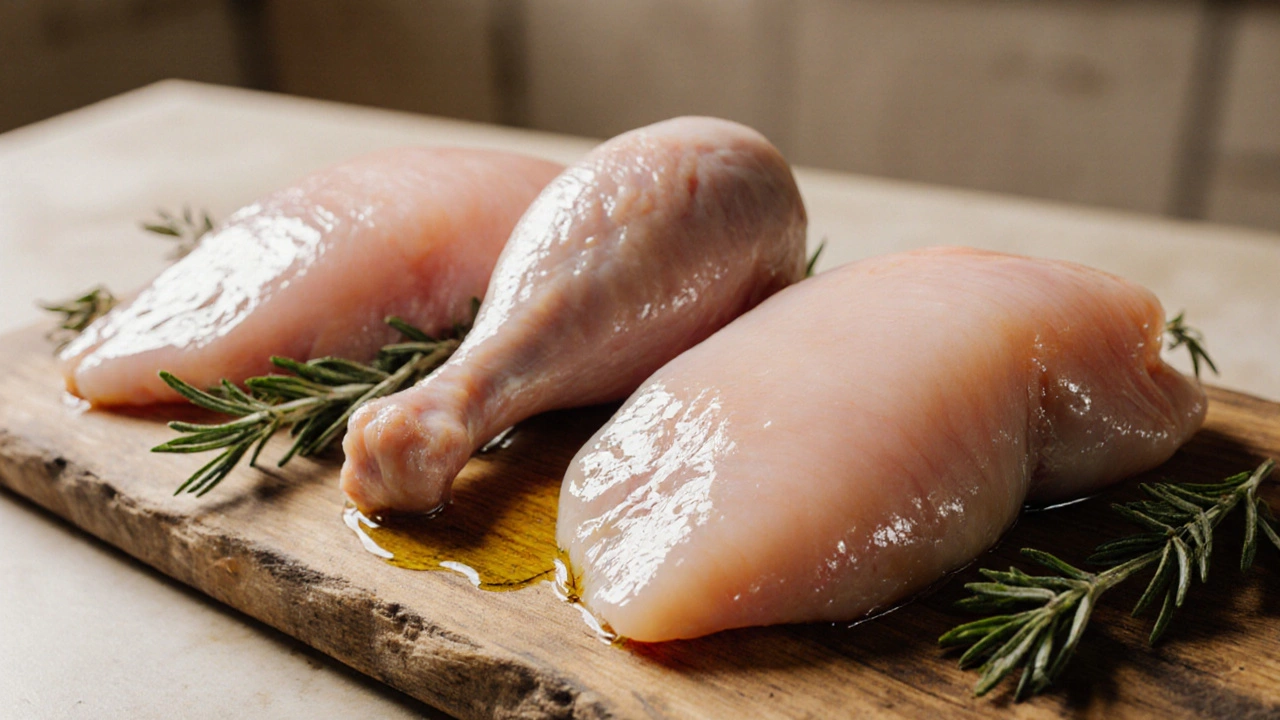Diabetic Chicken Calculator
Chicken Nutrition Calculator
Your Chicken Portion
When managing diabetes, Chicken is a versatile protein that can fit into almost any meal plan. But not every cut, preparation, or seasoning is created equal for blood‑sugar control. This guide tells you exactly which type of chicken works best for diabetics, why the classic tandoori style is a smart choice, and how to cook it without spiking glucose levels.
Understanding Diabetes and Protein Needs
Diabetes is a condition where the body struggles to regulate blood‑sugar. The American Diabetes Association recommends balancing carbs with high‑quality protein and healthy fats at every meal. Protein helps slow glucose absorption, keeps you full longer, and preserves muscle mass-crucial for long‑term metabolic health.
Ideal protein sources for diabetics share three traits:
- Low saturated fat
- Minimal added sugars or carbs
- Rich in essential nutrients like iron, zinc, and B‑vitamins
Chicken ticks all three boxes when you pick the right cut and cooking method.
Different Chicken Cuts and Their Nutrition Profiles
Not all chicken pieces are created equal. Let’s break down the most common cuts and see how they measure up against diabetic‑friendly criteria.
- Skinless chicken breast - The leanest option, about 31g protein and 1g fat per 100g. Very low in calories, making it ideal for weight‑management, a key part of diabetes care.
- Chicken thigh (skinless) - Offers 26g protein and 5g fat per 100g. The extra fat is mostly monounsaturated, which can improve satiety without hurting glycemic control.
- Chicken drumstick (skinless) - Similar protein to thigh but slightly higher in fat (6g per 100g). Still a good choice if you prefer dark meat.
- Chicken wing (with skin) - Highest fat content (around 20g per 100g) and lower protein density, making it less suitable for regular diabetic meals.
Notice the pattern: the best chicken for diabetics is the lean, skinless varieties that keep saturated fat low while delivering a solid protein punch.
Why Tandoori Style Works for Diabetics
Tandoori chicken isn’t just a flavor bomb; it’s also a smart cooking method for blood‑sugar control.
- Glycemic Index - The GI measures how quickly a food raises blood glucose. Chicken itself has a GI of zero, but marinades can add hidden carbs. Traditional tandoori uses plain yogurt, lemon juice, and spices-none of which raise the GI.
- The high heat of a tandoor or grill quickly sears the surface, creating a flavorful crust while keeping the interior juicy. This means you need less added oil, aligning with the Lean protein principle.
- Spices like turmeric, cumin, and paprika have anti‑inflammatory properties that may improve insulin sensitivity, a bonus for diabetics.
In short, tandoori chicken delivers flavor without the sugar‑laden sauces that often hide in other Indian dishes.
How to Choose the Best Chicken Cut - Comparison Table
| Cut | Protein (g) | Fat (g) | Calories | Best for |
|---|---|---|---|---|
| Breast | 31 | 1 | 165 | Low‑calorie, high‑protein meals |
| Thigh | 26 | 5 | 209 | Satiety‑boosting, richer flavor |
| Drumstick | 24 | 6 | 215 | Convenient bite‑size, dark meat lovers |
For most diabetics, the breast is the go‑to cut because it maximizes protein while minimizing calories and fat. If you crave dark meat, the thigh offers a good trade‑off without adding unhealthy saturated fat.

Practical Tips for Cooking Low‑Glycemic Chicken
- Trim all visible fat and remove skin before marinating. This reduces saturated fat and calories.
- Use Olive oil or a light spray instead of butter. One teaspoon per 100g is enough to keep the meat moist.
- Stick to plain Yogurt (unsweetened, full‑fat) for the tandoori base. Yogurt adds protein and calcium without carbs.
- Add acid (lemon or lime juice) to the marinade. Acid helps break down muscle fibers, making the chicken tender faster, so you can cook at a lower temperature and avoid charring.
- Grill or bake at 200°C (390°F) for 15‑20minutes, turning once. Use a meat thermometer - internal temperature should hit 74°C (165°F).
- Serve with high‑fiber sides like roasted cauliflower, sautéed spinach, or a mixed salad. Fiber further blunts any glucose rise.
Sample Diabetic‑Friendly Tandoori Chicken Recipe
This recipe keeps carbs under 5g per serving and packs 30g of protein.
- 500g skinless chicken breast, cut into bite‑size pieces
- 150g plain Greek yogurt (unsweetened)
- 1tbsp olive oil
- 2tbsp lemon juice
- 1tsp turmeric
- 1tsp ground cumin
- 1tsp smoked paprika
- ½tsp chili powder (optional)
- Salt and black pepper to taste
Mix yogurt, oil, lemon juice, and spices in a bowl. Add chicken, coat well, and refrigerate for at least 30minutes (or up to 4hours). Pre‑heat the grill, thread chicken onto skewers, and cook 12‑15minutes, turning once. Serve with a side of roasted Brussels sprouts tossed in a drizzle of olive oil and a squeeze of lemon.
Common Mistakes to Avoid
- Using sugary sauces (e.g., maple glaze) - they add hidden carbs and spike glucose.
- Leaving the skin on - skin contributes most of the saturated fat in chicken.
- Over‑cooking - dry chicken can lead you to add extra butter or cream to rescue the texture.
- Relying on deep‑fried variants - frying adds unnecessary calories and unhealthy fats.

Quick Checklist for Diabetic‑Safe Chicken
- Choose skinless, lean cuts (breast > thigh > drumstick).
- Marinate with unsweetened yogurt, lemon, and spices.
- Cook by grilling, baking, or broiling - avoid frying.
- Pair with high‑fiber, non‑starchy vegetables.
- Monitor portion size - 100‑150g per meal is a good target.
Frequently Asked Questions
Frequently Asked Questions
Can I use chicken with skin for a diabetic diet?
Skin adds a lot of saturated fat and extra calories, which can worsen insulin resistance. If you really love the skin, limit it to a small portion once a week and pair it with plenty of fiber‑rich veggies.
Does tandoori cooking raise the glycemic index of chicken?
No. Chicken itself has a GI of zero, and the classic tandoori marinade contains no added sugars. The high‑heat grilling sears the meat quickly, preserving its low‑glycemic profile.
How much chicken is safe to eat in one meal?
A standard portion is about 100‑150g (roughly the size of a deck of cards). This provides 20‑30g of protein without excess calories.
Are there any specific spices that help blood‑sugar control?
Turmeric contains curcumin, which research links to improved insulin sensitivity. Cinnamon and fenugreek also show modest glucose‑lowering effects when used regularly.
Should I count chicken carbs in my daily tally?
Pure chicken contains virtually no carbs. Only count carbs that come from marinades, sauces, or side dishes.
